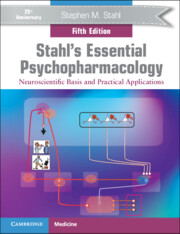Book contents
- Stahl’s Essential Psychopharmacology
- Additional material
- Stahl’s Essential Psychopharmacology
- Copyright page
- Contents
- Preface to the Fifth Edition
- CME Information
- 1 Chemical Neurotransmission
- 2 Transporters, Receptors, and Enzymes as Targets of Psychopharmacological Drug Action
- 3 Ion Channels as Targets of Psychopharmacological Drug Action
- 4 Psychosis, Schizophrenia, and the Neurotransmitter Networks Dopamine, Serotonin, and Glutamate
- 5 Targeting Dopamine and Serotonin Receptors for Psychosis, Mood, and Beyond: So-Called “Antipsychotics”
- 6 Mood Disorders and the Neurotransmitter Networks Norepinephrine and γ-Aminobutyric Acid (GABA)
- 7 Treatments for Mood Disorders: So-Called “Antidepressants” and “Mood Stabilizers”
- 8 Anxiety, Trauma, and Treatment
- 9 Chronic Pain and Its Treatment
- 10 Disorders of Sleep and Wakefulness and Their Treatment: Neurotransmitter Networks for Histamine and Orexin
- 11 Attention Deficit Hyperactivity Disorder and Its Treatment
- 12 Dementia: Causes, Symptomatic Treatments, and the Neurotransmitter Network Acetylcholine
- 13 Impulsivity, Compulsivity, and Addiction
- Suggested Reading and Selected References
- Index
9 - Chronic Pain and Its Treatment
- Stahl’s Essential Psychopharmacology
- Additional material
- Stahl’s Essential Psychopharmacology
- Copyright page
- Contents
- Preface to the Fifth Edition
- CME Information
- 1 Chemical Neurotransmission
- 2 Transporters, Receptors, and Enzymes as Targets of Psychopharmacological Drug Action
- 3 Ion Channels as Targets of Psychopharmacological Drug Action
- 4 Psychosis, Schizophrenia, and the Neurotransmitter Networks Dopamine, Serotonin, and Glutamate
- 5 Targeting Dopamine and Serotonin Receptors for Psychosis, Mood, and Beyond: So-Called “Antipsychotics”
- 6 Mood Disorders and the Neurotransmitter Networks Norepinephrine and γ-Aminobutyric Acid (GABA)
- 7 Treatments for Mood Disorders: So-Called “Antidepressants” and “Mood Stabilizers”
- 8 Anxiety, Trauma, and Treatment
- 9 Chronic Pain and Its Treatment
- 10 Disorders of Sleep and Wakefulness and Their Treatment: Neurotransmitter Networks for Histamine and Orexin
- 11 Attention Deficit Hyperactivity Disorder and Its Treatment
- 12 Dementia: Causes, Symptomatic Treatments, and the Neurotransmitter Network Acetylcholine
- 13 Impulsivity, Compulsivity, and Addiction
- Suggested Reading and Selected References
- Index
Summary
This chapter will provide a brief overview of chronic pain conditions associated with different psychiatric disorders and treated with psychotropic drugs. Included here are discussions of the symptomatic and pathophysiological overlap between disorders with pain and many other disorders treated in psychopharmacology, especially depression and anxiety. Clinical descriptions and formal criteria for how to diagnose painful conditions are only mentioned here in passing. The reader should consult standard reference sources for this material. The discussion here will emphasize how discoveries about the functioning of various brain circuits and neurotransmitters – especially those acting upon the central processing of pain – have impacted our understanding of the pathophysiology and treatment of many painful conditions that may occur with or without various psychiatric disorders. The goal of this chapter is to acquaint the reader with ideas about the clinical and biological aspects of the symptom of pain, how it can hypothetically be caused by alterations of pain processing within the central nervous system, how it can be associated with many of the symptoms of depression and anxiety, and finally, how it can be treated with several of the same agents that can treat depression and anxiety. The discussion in this chapter is at the conceptual level, and not at the pragmatic level. The reader should consult standard drug handbooks (such as Stahl’s Essential Psychopharmacology: the Prescriber’s Guide) for details of doses, side effects, drug interactions, and other issues relevant to the prescribing of these drugs in clinical practice.
- Type
- Chapter
- Information
- Stahl's Essential PsychopharmacologyNeuroscientific Basis and Practical Applications, pp. 379 - 400Publisher: Cambridge University PressPrint publication year: 2022



